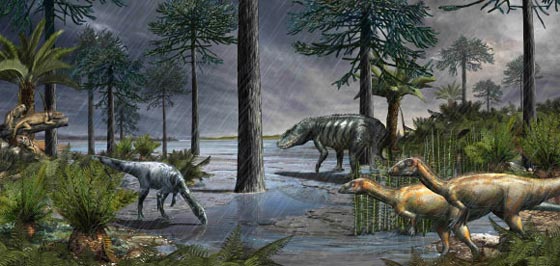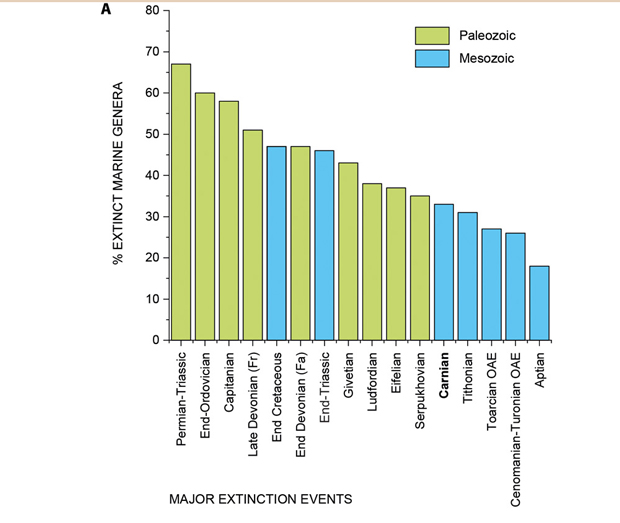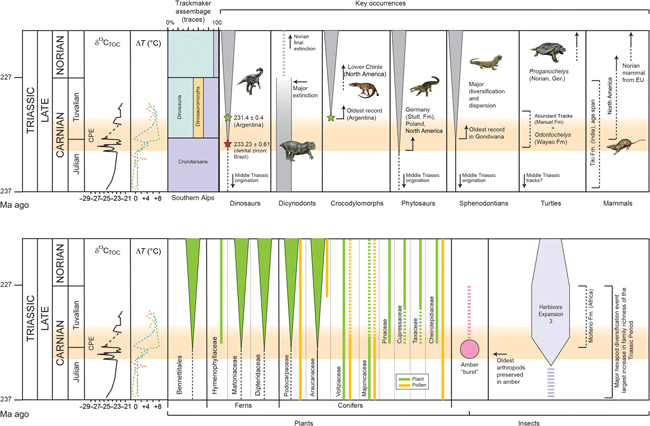Getting to Grips with a Mass Extinction Event – Carnian Pluvial Episode
The fossil record of the Phanerozoic (the Eon of visible life), indicates that there were five major mass extinction events. The fossil record marks huge and very rapid (at least in geological terms anyway), reductions in the diversity of life on a world-wide scale. Our planet might well be going through a mass extinction event at the moment, but for one team of scientists their attention has been on the Late Triassic (Carnian faunal stage), plotting a time of extensive terrestrial and marine faunal turnover.
Examining the Impact of the Carnian Pluvial Episode
The researchers, which include scientists from Bristol University, the University of Ferrara (Italy), the University of Vienna and the China University of Geosciences in Wuhan Province, conclude that around 233 million years ago about a third of all marine genera disappeared.
Terrestrial Fauna in the Late Triassic – Did a Major Extinction Event Help to Trigger the Rise of the Dinosaurs

Picture credit: Davide Bonadonna
Many types of land-living animal did no better. The herbivorous rhynchosaurs and dicynodonts were greatly reduced in diversity during the Carnian, but intriguingly crocodylomorphs and those other archosaurs, the Dinosauria seem to have benefitted from the extinction of other types of tetrapod, with both the Crocodylomorpha and dinosaurs diversifying towards the end of the Carnian. The scientists postulate that the rise of the dinosaurs to dominance might have been a direct consequence of the Carnian Pluvial Episode (CPE).
To read an earlier blog article that links the CPE with dinosaur diversification: Out with a Bang! In with a Bang! The story of the Dinosauria.
A Time of Immense Global Environmental Change
The Carnian Pluvial Episode took place from around 234 to 232 million years ago. There was a marked rise in rainfall (at least four episodes of increased rainfall have been deduced from sedimentary and palaeontological data). The Earth got warmer and more humid. This led to extensive environmental changes and the subsequent demise and then collapse of many ecological systems.
Writing in the academic journal “Science Advances”, the scientists throw their collective weight behind the theory that enormous volcanic eruptions in the Wrangellia Province of western Canada, that resulted in the deposition of vast amounts of basalt, were probably the cause of the global environmental changes.
Co-author of the paper Jacopo Dal Corso (China University of Geosciences), explained:
“The eruptions peaked in the Carnian. I was studying the geochemical signature of the eruptions a few years ago and identified some massive effects on the atmosphere worldwide. The eruptions were so huge, they pumped vast amounts of greenhouse gases like carbon dioxide and there were spikes of global warming”.
This warming resulted in the increased humidity and higher levels of rainfall, a phenomenon first detected by geologists Mike Simms and Alastair Ruffell in the 1980s. The climate change caused major biodiversity loss in the ocean and on land, but just after the extinction event new groups took over, forming more modern-like ecosystems.
Environmental and Geochemical Changes of the CPE

Picture credit: Jacopo Dal Corso et al/Science Advances
A Provide Effect on Planet Earth
The environmental changes had a profound effect on life on our planet. As well as a diversification of the dinosaurs, many other modern groups of animals and plants appeared at this time, including lizards and the first mammals. When mapping the losses of marine fauna at the genus level, the team concluded that whilst the CPE was not as devastating as the either the end-Triassic or end-Cretaceous extinction events, some 33% of all marine genera died out.
A Comparison of Marine Faunal Turnover During Major Extinction Events

Picture credit: Jacopo Dal Corso et al/Science Advances
The Effect on Plant Life
The shifts in climate encouraged substantial changes in global flora too. Many new types of plants emerged that were more suited to the humid climate. Several modern fern families emerged and the Bennettitales (cycad-like plants), diversified. Extensive coal deposits formed once again, the first substantial coal seams being produced since the Permian. Conifers seem to have benefitted and the researchers, which include Professor Mike Benton (Bristol University), remark that the CPE provides the first major finds of amber in the fossil record. As tree resin is usually produced when plants are under stress, this suggests that terrestrial ecosystems were in a state of flux during this period in Earth’s history.
Professor Benton stated:
“The new floras probably provided slim pickings for the surviving herbivorous reptiles. I had noted a floral switch and ecological catastrophe among the herbivores back in 1983 when I completed my PhD. We now know that dinosaurs originated some 20 million years before this event, but they remained quite rare and unimportant until the Carnian Pluvial Episode hit. It was the sudden arid conditions after the humid episode that gave dinosaurs their chance.”
Terrestrial Extinctions and Originations During the Carnian (Late Triassic)

Picture credit: Jacopo Dal Corso et al/Science Advances
The Impact of the Carnian Pluvial Episode
The researchers conclude that the CPE may not have been as significant as the big five Phanerozoic mass extinctions but it did have a dramatic impact on terrestrial and marine environments and helped to bring in a variety of new types of plants and animals, marking an important step towards the origins of the types of ecosystems we see around us today.
The scientific paper: “Extinction and dawn of the modern world in the Carnian (Late Triassic)” by Jacopo Dal Corso et al published in Science Advances.
The Everything Dinosaur website: Everything Dinosaur.






Leave A Comment